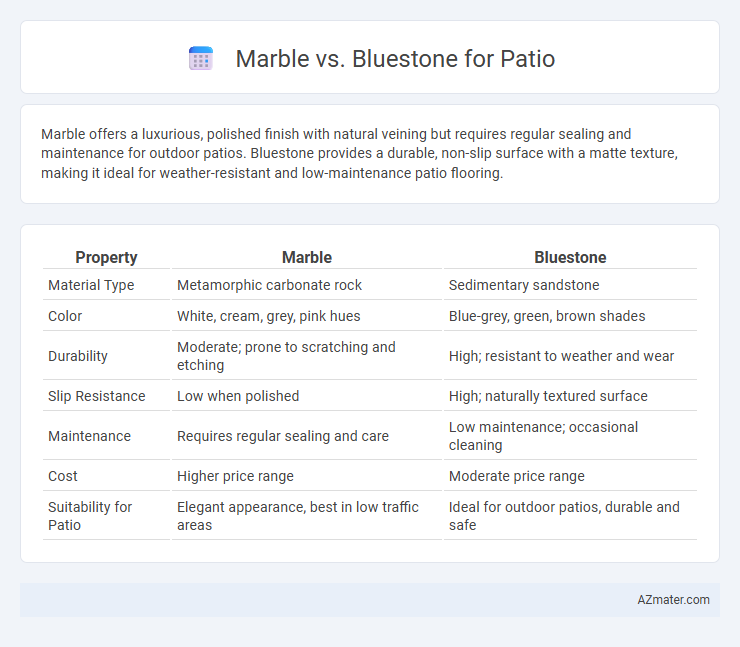Marble offers a luxurious, polished finish with natural veining but requires regular sealing and maintenance for outdoor patios. Bluestone provides a durable, non-slip surface with a matte texture, making it ideal for weather-resistant and low-maintenance patio flooring.
Table of Comparison
| Property | Marble | Bluestone |
|---|---|---|
| Material Type | Metamorphic carbonate rock | Sedimentary sandstone |
| Color | White, cream, grey, pink hues | Blue-grey, green, brown shades |
| Durability | Moderate; prone to scratching and etching | High; resistant to weather and wear |
| Slip Resistance | Low when polished | High; naturally textured surface |
| Maintenance | Requires regular sealing and care | Low maintenance; occasional cleaning |
| Cost | Higher price range | Moderate price range |
| Suitability for Patio | Elegant appearance, best in low traffic areas | Ideal for outdoor patios, durable and safe |
Introduction to Marble and Bluestone Patios
Marble patios are prized for their elegant, smooth surface and natural veining, offering a luxurious aesthetic that enhances outdoor spaces. Bluestone patios feature a dense, fine-grained sandstone with a rich blue-gray color, known for durability and slip resistance. Both materials provide distinct styles and performance characteristics, making them popular choices for outdoor paving depending on design preferences and climate conditions.
Aesthetic Differences: Marble vs Bluestone
Marble patios offer a sleek, luxurious appearance with a smooth, polished surface and natural veining that reflects light beautifully, making them ideal for elegant outdoor spaces. Bluestone provides a more textured, rustic aesthetic with its matte finish and earthy blue-gray tones, blending seamlessly into natural landscapes. Choosing between marble and bluestone depends on the desired visual impact: refined sophistication versus organic, rugged charm.
Durability and Longevity Comparison
Marble offers a classic, elegant look but is softer and more prone to scratches, stains, and weathering over time, which can reduce its durability for patio use. Bluestone, a dense, natural sandstone, provides superior resistance to chipping, cracking, and fading, making it ideal for outdoor patios exposed to varying weather conditions. The longevity of bluestone typically surpasses marble due to its hardness and low porosity, ensuring its appearance and structural integrity last for decades.
Cost Considerations for Marble and Bluestone
Marble patios generally command higher costs due to their luxurious appearance, durability, and the intricate quarrying process involved, with prices ranging from $10 to $30 per square foot. Bluestone offers a more budget-friendly alternative, typically priced between $6 and $12 per square foot, making it a popular choice for cost-conscious projects while still providing excellent durability and natural slip resistance. Installation costs for both materials vary based on labor complexity and geographic location, but marble often incurs higher expenses due to its weight and precision cutting requirements.
Maintenance Requirements for Each Material
Marble patios require regular sealing and cleaning to prevent staining and etching due to their porous nature and susceptibility to acidic substances. Bluestone offers lower maintenance needs, as it resists scratches and staining better and can be cleaned with mild soap and water without frequent sealing. Choosing bluestone reduces long-term upkeep costs and effort compared to marble, which demands more intensive care to maintain its polished appearance.
Slip Resistance and Safety Factors
Bluestone offers superior slip resistance compared to marble, making it a safer choice for patios, especially in wet or icy conditions. The natural rough texture of bluestone provides excellent traction, reducing the risk of slips and falls. Marble, while elegant, tends to be smoother and more prone to becoming slippery when wet, requiring additional treatments or maintenance to improve its safety on outdoor patio surfaces.
Weather Resistance: Handling Extreme Conditions
Marble offers elegant aesthetics but is prone to weather-related wear such as cracking and discoloration in extreme freeze-thaw cycles, making it less ideal for patios exposed to harsh winters. Bluestone demonstrates superior weather resistance due to its dense composition, effectively withstanding temperature fluctuations, moisture, and UV exposure without significant degradation. For outdoor patios requiring durability in extreme weather conditions, bluestone provides a more reliable, low-maintenance option compared to marble.
Installation Process and Complexity
Marble patios require precise cutting and professional handling due to their delicate nature and susceptibility to cracking, making installation more complex and time-consuming. Bluestone offers a more straightforward installation process with its uniform thickness and durability, allowing for easier cutting and fitting. Both materials demand proper subbase preparation for optimal drainage, but marble often needs extra care to prevent staining during installation.
Environmental Impact and Sustainability
Marble, a natural metamorphic stone, has a higher environmental impact due to energy-intensive quarrying and processing methods, resulting in significant carbon emissions. Bluestone, a dense sedimentary rock predominantly sourced from sustainable quarries in the northeastern United States, requires less extraction energy and offers better durability, making it a more eco-friendly choice for patios. Both stones are recyclable, but bluestone's lower carbon footprint and longer lifespan contribute to greater sustainability in outdoor applications.
Choosing the Best Option for Your Patio
Marble and bluestone are popular choices for patios, each offering distinct advantages depending on your aesthetic preferences and climate. Marble provides a luxurious, polished look with a smooth surface but requires regular sealing and can be prone to staining and weathering in harsh conditions. Bluestone, a dense and durable natural stone, offers excellent slip resistance and withstands outdoor elements better, making it ideal for high-traffic areas and regions with variable weather.

Infographic: Marble vs Bluestone for Patio
 azmater.com
azmater.com